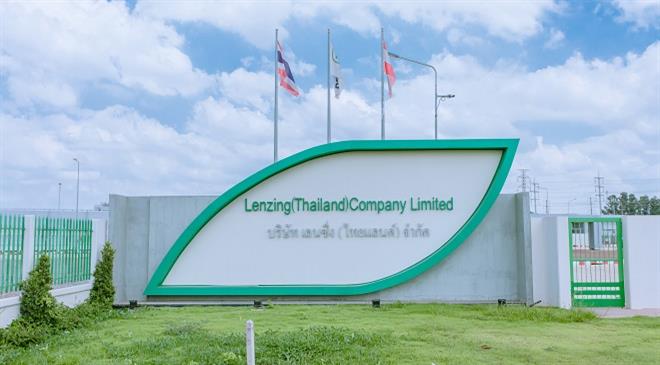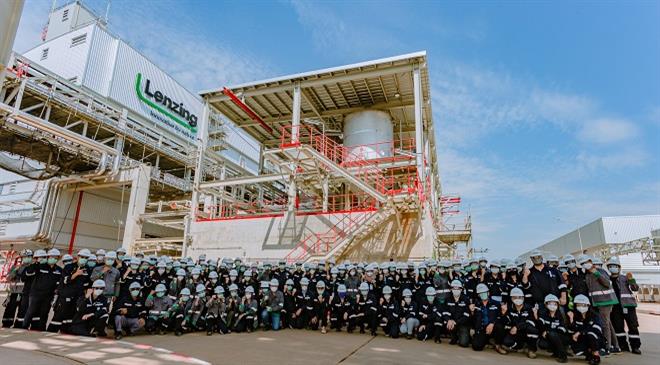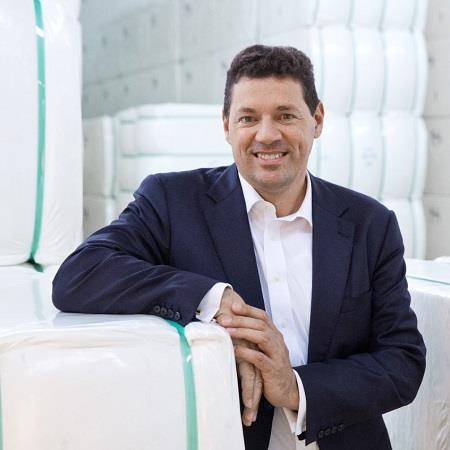World’s largest plant for lyocell production
Lenzing has today (March 3, 2022) launched the state-of-the-art lyocell production plant in Thailand. The Austria-headquartered company’s Chief Commercial Officer Robert van de Kerkhof speaks exclusively to Fibre2Fashion on the new plant, sustainability, innovations and much more.
The state-of-the-art lyocell production plant that Lenzing has launched today in Thailand is the world’s largest such plant. Could you share details on what will be the production capacity like and what all will be produced there?
Yes, it’s the world’s largest plant for the lyocell fibre. Lyocell is a fairly new fibre when it comes to fashion, although the first commercial lyocell plant was built about 28 years ago in Mobile, Alabama. This shows how long it takes for a fibre to become commercial. The plant that we are building will have a capacity of up to 100,000 tonnes, compared to alternative capacities of 20,000 to 30,000 tonnes. That’s why a single line of 100,000 tonnes is really unique in the world.

We all know that the textile industry is moving towards sustainability one step at a time. So, what should be a 360-degree approach to help imbibe this in the entire value chain? Most of the textiles and apparel value chain is still dominated by cotton and polyester fibres, though new recycled or sustainable fibre materials are coming in. But with brands and retailers having specific sustainability targets or climate change targets, what should be the 360-degree approach that we can follow?
We are currently at the beginning of a very long journey in greening the textile value chain, and we are seeing different initiatives too. Of course, with the sustainable power coalition, you see bigger push to transparency. We really need to understand what exactly the environmental impact of each of the products is. So, for instance, a lot of companies, brands and retailers are committing to recycled polyester, which is in principle good news as long as you can avoid virgin polyester, as your greenhouse gases will be much lower. So that is something to be welcomed. But what is also a pity is that it’s not recycling fibres. And if you’re really talking about circularity as being a major game changer for the very polluting textile industry, you need to take responsibility as an industry to recycle your own products. So, we need to go to such a distance where we as industry leaders—right from fibre producers all the way to the fabric makers and retailers—are actually going to take responsibility for the waste that we generate. And it’s the waste of unsold garments, the waste throughout the value chain, but there’s also the end of life of a garment. So, what is a consumer going to do with it? And if we take responsibility, it means that we need to develop recyclable technologies that are able to really extract raw materials for new fibres. It is very, very complex at this moment to make polyester fibre to go back into a new polyester fibre. I think that is really critical for a circular economy to work and achieve full transparency. So, for instance, if I know I have some old clothing in my cupboards that I don’t need it anymore, I don’t even know what is in it. Unfortunately, you’ll find a lot of the garments that don’t have the correct labels on it. For example, if I pick a 100 per cent cotton t-shirt, it’s not really 100 per cent cotton. There might be a little bit polyester in it as thread, which really becomes a big issue while speaking of a true circular economy, because I cannot recycle it.
At this moment at Lenzing we have the REFIBRA technology, with which we can reduce the amount of wood by at least 30 per cent and replace the virgin woods with recycled cotton. Recycled cotton has much lower CO2 emissions, and doesn’t have the same water consumption. So, it’s an extremely good product for the environment. But the moment we recycle a garment that has polyester in it, it would be a significant risk to our production process, as it cannot handle polyester content in it. So, we need to get to a production process where we can collect, then sort and separate the fibrous and the raw materials, making them ready for reuse, again, to really have purity that allows good fibre productions. We are just at the beginning of this journey as an industry. But there are a lot of initiatives taking place. There are companies that are driving transparency that really shows where the fibre is being made, what has happened to it from the fibre to the garment stage. I’m looking at technologies that really can show the exact length of different fibres all the way from the fibre producer to the garment. It’s very important to have startups that show what really is in the garment, which I think is very important.
And then you have government initiatives like the European Union’s, and supporting environmental footprint is vital to all such initiatives aimed at improving transparency, which is going to be a major step forward. And then, there are people that do produce sustainable fibres like we will in Thailand that are carbon zero and fully biobased and biodegradable. It’s our responsibility to continue to invest to meet the increasing demand for the consumers. That is our responsibility because a lot of brands and retailers would like to buy more fibres. Lyocell is a small fraction of overall cotton. So, there is a sustainable fibre gap, and there’s much more demand for sustainable fibres.
In addition to textiles, there are technical textiles and the plastics industry which use polyester and polypropylene and are looking at the same sustainable fibres. They are also looking at cotton and wood-based cellulose fibres like lyocell. So, there will be very rapid increase in demand and it’s up to the fibre producers to make more of the sustainable fibre available. And with the targets being set with transparency, we will come a long way.
Like you pointed out we currently see a lot of alternative sustainable materials coming in the industry, for example banana fibre and hemp. So, do we also see Lenzing introducing some new sustainable fibres soon, apart from all the established ones that you have in the market?
We definitely continue to look at ideas that are going to be greening the value chain. When I say greening the value chain, I mean that every fibre that Lenzing brings new to the market to have a lifecycle analysis (LCA) that is equal or better than its predecessor. So, we continue to become better in terms of what we provide the market with. The only exception I could accept would be products like our Modal indigo blue. That would be a new modal version, where we add the indigo pigments in the fibre itself. By doing this you save so much water and bring dyeing pollutions down in the value chain, plus you make the garment much better that you have a much longer life, as it can withstand many more washing cycles. So, while we make that as a significantly big step, when it comes to adding pigments, it makes a little bit worse from a LCA perspective. From a consumer perspective, all the optimisation in the value chain really made this a better product. So, that is an example of a product that we launched last year. And it definitely will be a major improvement for the denim industry.
When you then look at other fibres, the lyocell having a production process where you can really have 99.6-99.9 per cent of the dissolving agent being reused in a completely closed loop. I can almost set up the lyocell plant in the middle of a city because it doesn’t have any emissions that a normal factory would have. Because once you put the raw materials in and they stay in the process except for the raw material woods that comes in and goes out as a fibre. So, it’s a very clean production process. And I believe that there we’re just at the beginning of a much bigger generation of fibre. So, a fundamental new fibre I do not see yet. But further improvements on the lyocell technology – there I see for sure significant improvement possibilities. Another good example is the product that we launched as limited edition was the orange fibre, which we relaunched with the Orange Fiber company – the limited edition of lyocell with the skin of oranges that I think is a great innovation. But we’re also talking about brand new technologies like filament. So, for instance, I have a tie which really feels and looks like silk, but it’s 100 per cent wood based, it’s 100 per cent lyocell filament. We call it TENCEL Luxe. And it is really the standard now of sustainability in the haute couture industry. It really feels like silk.
In short, a lot of innovations are currently entering the market; we have a very healthy pipeline of new innovations to go, and a lot of that will be based on the lyocell technology.

Lenzing has always been on the forefront when it comes to sustainability. So, what would be the unique features of this particular plant that we can term it as the next level of sustainability in the textiles industry?
The TENCEL lyocell fibre is already one of the cleanest fibres, and if you look at, for instance, the Higg Index, you can see that the normal lyocell is much cleaner than the viscose and modal fibre, and when you compare it to cotton items, the use of pesticides and water consumption are much, much lower. Now, what lyocell does do is it’s more energy intense. So, from that perspective, there is a potential risk if the energy is not green. So, what is really unique about what we’re doing in Thailand is that we have full biomass energy. That means that our aim is to have the 100,000 tonnes of lyocell capacity to be carbon neutral. We do expect that it will be a carbon zero lyocell fibre that we’ll be producing there to be 100 per cent. And that makes it very unique.
You have started production today at the new Thai plant. Can you claim it to be a carbon-zero facility from today itself?
No, we will need several months of production to get all the certifications. So, when we make the claim of being carbon-zero facility, we need to prove that. We want to have the EU Ecolabel certification. All these different certifications that we need to have would take a few months. And this can be done only once the plant is up and running. But at this moment, I hope and expect all certification to be completed in approximately six months from now, because that’s how long it takes.
What do you foresee for Lenzing in the year 2022?
We are branding our lifestyle technology as TENCEL fibre. And I’m also very proud that this June will be 30 years of TENCEL fibre brand. So, it is for me a very exciting year to one side celebrate 30 years of TENCEL brand, at the same time opening the Thailand facility. And I really think that 2022 will be an extremely exciting year for Lenzing and the TENCEL brand.
Oh, that’s wonderful. And of all the countries any particular reason to choose Thailand for your lyocell fibre plant?
It’s a very good question, in fact. We did look for a long time for a good location. We had been scouting different options. Lenzing, of course being Austria based, has at this moment already quite some lyocell capacity in the United States, in UK, and in Austria. And we were looking for a facility outside Europe to expand our capacities. We did have, at that time, multiple options. We could go almost to any country. We could build it very close to our facility in Indonesia where we have already produced viscose and have good experience. We could install it in China where we have also a viscose facility and are now investing in expanding the capacity of our modal fibre, and we are also there greening the energy. Those were the key options.
But then if we look at the industry trends now, you see that our direct customer – the spinners and also the weaving capacities is reducing in China, and more and more investments are being made in the textile industry outside China. And as a consequence, Thailand is really a very well-situated country. Thailand has free trade agreements (FTAs) with several countries. You can easily ship to India, Pakistan, Bangladesh, which of course are extremely important markets. You see more and more investments coming in Vietnam, which are very important for us. So, with FTAs, with the central location of Thailand, it’s very logical for us to be in the centre of this growth region.
But once you pick the right location as a country, you also need to have the right location for the site and what is really, for us, very good location right now. With Prachin Buri as the location where we have built the plant, we are having a facility that is not far from a big international port. So, we can easily bring in raw materials and export our fibre. I think that’s important for us and we are investing in our capacity in Prachin Buri Industrial Park 304, which has given us the access to the green energy that we need. It also already has good wastewater treatment facilities. So, we’ll have our own wastewater treatment.
We also have bought a piece of land that really allows us for significant expansion. So, the 100,000 tonnes capacity is the first major investment, but we can also invest further there in lyocell capacities. In addition to location, Thailand is preferred also from a skill perspective. The lyocell production process requires quite some skills, and those skilled labour people are available in Thailand, which is very important to have. And I have to also admit that the support that we got from the Bureau of Investment was absolutely superb. So, we really had great support on this project from the beginning. The moment we decided for Thailand, they have integrated for all the way until now. For instance, while we managed the whole COVID-19 crisis, considering the complexity involved in bringing in experts from abroad during the construction of the site, the Thai government has been very supportive. So, it’s been the right choice for us to invest in Thailand.
You correctly mentioned that a lot of facilities are now moving out of China specifically and moving on to other Asian nations. So, do you think that this setting of the plant in Thailand is going to have a positive impact in the Asian region, helping it retain its position as a production hub? Because nowadays, we are also talking about reshoring, onshoring, and other terms coming into picture specifically in the apparel sector? So, do you think this plant is going to be of positive impact for the Asian region considering the location advantages it has?
Absolutely. I think, in general, that’s because of the political stability of Thailand. The location, as I mentioned, is really very central, in addition to the very good trade relationships they have with all the Asian countries. I definitely think that this will be a major boost to the industry.
Speaking about near shoring, it is a trend that will take place, for instance, Europe will be sourcing maybe a little bit more from Turkey. But again, if you look at the overall major investments in spinning and weaving, it’s really in the Asian countries already. And that’s why we want to just be part of this accelerated growth, and also be in the right location when the growth really materialises. So, yes, I’m very optimistic about the growth of the textile industry in the ASEAN area.



